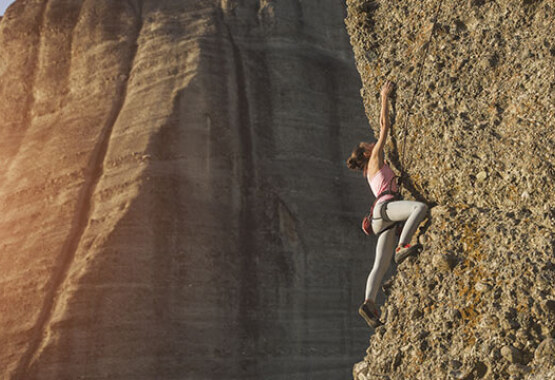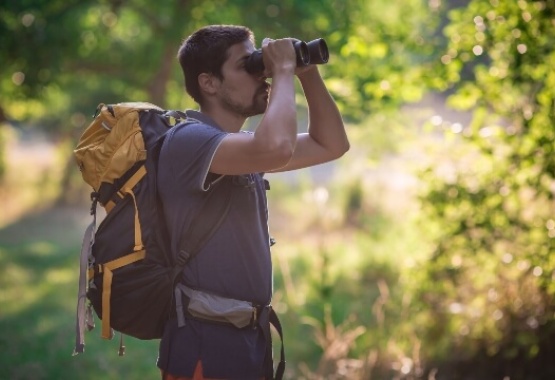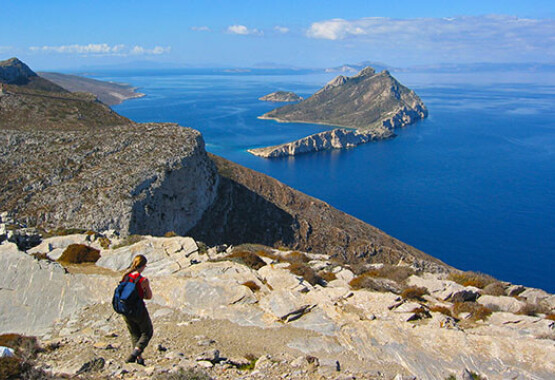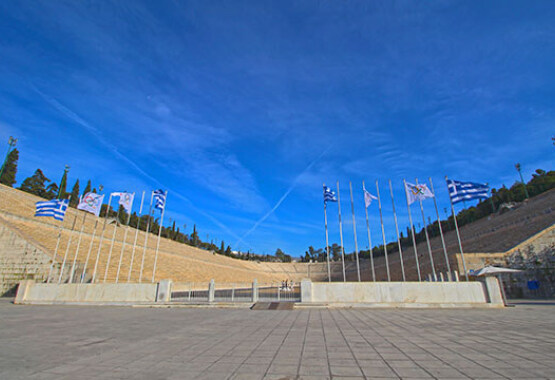
LITOCHORO
At approximately 400 km from Athens and 100 from Thessaloniki (Greece’s second biggest city) the area is ideal for the lovers of alternative activities, ranging from trekking to paragliding, canyoning, rafting, climbing, mountain-biking and jeep safari. But you don’t have to go extreme to have your personal Olympian moments. Mountaineering on Olympus is not only a divine experience but also an option covering all levels of difficulty and stamina.
• Litochoro – Golna – Castana source – Litochoro
The nearest town and home to 7.000 people, Litochoro is the starting point for day trips and tours around the area and on the mountain. Very easily accessible by car or train, this cute little town offers inexpensive and good accommodation. Follow the signs to reach the church of Agios Ioannis (Saint John) and then turn right heading to the church of Profitis Ilias which was first built by St. Dionysus in the 16th century. It's approximately an hour walk. Next you’ll reach the area of Golna where you will enjoy the fine views of the surrounding peaks and of the gorge of Enipeas. Go on NW on a trail which climbs down to the E4 path, connecting Litochoro to Prionia. When you are back in town you will have walked for approximately 4 hours, you will have been up to 960 m, and you will have crossed a part of the Enipeas gorge.
• Prionia – Agio Spilleo – Monastery of St. Dionysus
Leave your car at Prionia and start walking down the E4 path towards Litochoro. Turn right at the hut after the glades and before the old St. Dionysus monastery. You are just minutes away from the waterfalls of Enipeas. Breathe in the serenity and return to the E4 path by crossing Enipeas gorge through a wooden bridge. Before long you’ll find the Agio Spilleo. Tradition has it that St. Dionysus spent his days of asceticism here. At the completion of your two-hour walk you will have been up to 1100 m and you will have visited some of the most important historical and religious sites of the mountain.
• Krevatia Vrontous – Papa Aloni – Agia Triada
Despite the alternation of terrain, this walk won’t take you higher than 950 m and lower than 400 m, so it is easy to follow it in winter too. Start off at the refuge “Krevatia” in the area of Vrontou (950 m). Walk the old path on the descent to Agia Triada surrounded by the forest. Five minutes after you have crossed the river, there will be a fork. Take the path on the left and walk for another 40 minutes to reach the Papa Aloni site. When you go back to the fork you’ll take the other path to get to Agia Triada. But you can opt for a detour: at 30 minutes after the fork you’ll see an old path on your left. Follow it for 20 minutes and you will get to the waterfalls. Take a short break before going back to the main path and follow the stream all the way to Spilies (30 mins walk) and then to the end of the stream (35 mins walk) where you can head back to Vrontou.
Starting off at the Mili (Myloi) spot (400 m) you’ll need 5 hours to get to the Prionia spot (1100 m.). The international and well-maintained path of E4 is signposted and it will lead you through wooden bridges to cross the Enipeas gorge seven times. On the second half of the walk you’ll go past Agio Spilleo to reach the Monastery of St. Dionysus 20 minutes later. After another 10 minutes, trace the path on your left and follow it to the waterfalls of Enipeas. The uneven terrain requires stamina, but the beauty of the springs, the pools, the rock formations and the sheer slopes around you will be a fair reward.
• Gortsia – Petrostrouga – Plateau of the Muses
At the 14th kilometer on the road Litochoro-Prionia, go up a narrow road on your right hand and leave your car at the car park on its end. That’s the area of Gortsia, as well as the beginning of a wide path leading to the “Plateau of the Muses” and the refuges “Christos Kakkalos” (or “refuge C”, at the height of 2650 metres) and "Giosos Apostolidis” (the highest Greek refuge at 2700 metres). The two thirds of your six-hour-long walk will be through a beautiful forest, leaving the remaining one third to be done in alpine scenery with low vegetation. Attention: make sure to carry enough water supplies as you will come across no running water on your way. Your first point of reference will be the plateau “Barbas”. Your next one will be a cistern. In between the two you will be walking up a beech forest. At the height of 2000 metres there is the spot called Petrostrouga, known for the age-old white pine trees. Go further up to get to the “Skourta” peak (2485 m.) in the alpine zone. Continue on the narrow ridge to the Plateau of the Muses. Entering the plateau, the path splits in two. The left part leads to the “Christos Kakkalos” refuge (30 mins) and the right one to the “Giosos Apostolidis” refuge (40 mins). Take short walks from the former to the peak Toumba (2801 metres) and from the latter to the peak Profitis Ilias (2803 metres).
• Refuge Spilios Agapitos – Scala – Mytikas
Also known as “Refuge A”, Spilios Agapitos is situated at 2100 metres and your starting point for this three-hour-long walk. Go upwards until you get to the turn for “Zonaria” on your right hand. You are now at 2480 metres. A bit further up you come across another path, leading to Stavraities and Agios Antonios. The peak of Scala, at 2866 metres, is just a stop on the way to Mytikas. Attention: this last part of your walk is rather difficult.
On the fifth kilometer of the forest road “Petra-Kokkinoplou” you’ll see a small road on your left hand with a metal bar at its entrance. Follow it for another 10 mins to cross the Naoum stream. Leave your car there and keep following the path on the side of the stream. At “Kazania” you will have to choose between the old path passing just under the high peaks, and the yellow-signed new path leading to “Portes” (2700 m.).
• Plateau of the Muses – Peaks
The refuges “Christos Kakkalos” and “Giosos Apostolidis” will be your points of departure this time. The trail goes uphill to “Portes” and then “Stefani”. On the location between those two peaks you’ll be able to see Mytikas on your left and Stefani on your right. Follow the red arrows on the rock to get to Mytikas in some 30-40 minutes. Landfalls might add a touch of adventure to your walk, but don’t worry about your adrenaline: you’ll be in ecstasy anyway as you will have set foot on the abode of the Gods.
Mountaineering on Olympus
Mountaineering on the abode of the Gods
Mt. Olympus’ wonderful nature of rich flora (over 1700 species, more than 20 of which endemic) and fauna (more than 30 species of mammals, 100 species of birds, 18 species of reptiles) left the modern Greeks with no choice but to proclaim it the first National Forest in 1938.At approximately 400 km from Athens and 100 from Thessaloniki (Greece’s second biggest city) the area is ideal for the lovers of alternative activities, ranging from trekking to paragliding, canyoning, rafting, climbing, mountain-biking and jeep safari. But you don’t have to go extreme to have your personal Olympian moments. Mountaineering on Olympus is not only a divine experience but also an option covering all levels of difficulty and stamina.
Here are some of the most beautiful trails
1. Easy trails:• Litochoro – Golna – Castana source – Litochoro
The nearest town and home to 7.000 people, Litochoro is the starting point for day trips and tours around the area and on the mountain. Very easily accessible by car or train, this cute little town offers inexpensive and good accommodation. Follow the signs to reach the church of Agios Ioannis (Saint John) and then turn right heading to the church of Profitis Ilias which was first built by St. Dionysus in the 16th century. It's approximately an hour walk. Next you’ll reach the area of Golna where you will enjoy the fine views of the surrounding peaks and of the gorge of Enipeas. Go on NW on a trail which climbs down to the E4 path, connecting Litochoro to Prionia. When you are back in town you will have walked for approximately 4 hours, you will have been up to 960 m, and you will have crossed a part of the Enipeas gorge.
• Prionia – Agio Spilleo – Monastery of St. Dionysus
Leave your car at Prionia and start walking down the E4 path towards Litochoro. Turn right at the hut after the glades and before the old St. Dionysus monastery. You are just minutes away from the waterfalls of Enipeas. Breathe in the serenity and return to the E4 path by crossing Enipeas gorge through a wooden bridge. Before long you’ll find the Agio Spilleo. Tradition has it that St. Dionysus spent his days of asceticism here. At the completion of your two-hour walk you will have been up to 1100 m and you will have visited some of the most important historical and religious sites of the mountain.
• Krevatia Vrontous – Papa Aloni – Agia Triada
Despite the alternation of terrain, this walk won’t take you higher than 950 m and lower than 400 m, so it is easy to follow it in winter too. Start off at the refuge “Krevatia” in the area of Vrontou (950 m). Walk the old path on the descent to Agia Triada surrounded by the forest. Five minutes after you have crossed the river, there will be a fork. Take the path on the left and walk for another 40 minutes to reach the Papa Aloni site. When you go back to the fork you’ll take the other path to get to Agia Triada. But you can opt for a detour: at 30 minutes after the fork you’ll see an old path on your left. Follow it for 20 minutes and you will get to the waterfalls. Take a short break before going back to the main path and follow the stream all the way to Spilies (30 mins walk) and then to the end of the stream (35 mins walk) where you can head back to Vrontou.
2. Trails of medium difficulty:
• Litochoro – PrioniaStarting off at the Mili (Myloi) spot (400 m) you’ll need 5 hours to get to the Prionia spot (1100 m.). The international and well-maintained path of E4 is signposted and it will lead you through wooden bridges to cross the Enipeas gorge seven times. On the second half of the walk you’ll go past Agio Spilleo to reach the Monastery of St. Dionysus 20 minutes later. After another 10 minutes, trace the path on your left and follow it to the waterfalls of Enipeas. The uneven terrain requires stamina, but the beauty of the springs, the pools, the rock formations and the sheer slopes around you will be a fair reward.
• Gortsia – Petrostrouga – Plateau of the Muses
At the 14th kilometer on the road Litochoro-Prionia, go up a narrow road on your right hand and leave your car at the car park on its end. That’s the area of Gortsia, as well as the beginning of a wide path leading to the “Plateau of the Muses” and the refuges “Christos Kakkalos” (or “refuge C”, at the height of 2650 metres) and "Giosos Apostolidis” (the highest Greek refuge at 2700 metres). The two thirds of your six-hour-long walk will be through a beautiful forest, leaving the remaining one third to be done in alpine scenery with low vegetation. Attention: make sure to carry enough water supplies as you will come across no running water on your way. Your first point of reference will be the plateau “Barbas”. Your next one will be a cistern. In between the two you will be walking up a beech forest. At the height of 2000 metres there is the spot called Petrostrouga, known for the age-old white pine trees. Go further up to get to the “Skourta” peak (2485 m.) in the alpine zone. Continue on the narrow ridge to the Plateau of the Muses. Entering the plateau, the path splits in two. The left part leads to the “Christos Kakkalos” refuge (30 mins) and the right one to the “Giosos Apostolidis” refuge (40 mins). Take short walks from the former to the peak Toumba (2801 metres) and from the latter to the peak Profitis Ilias (2803 metres).
• Refuge Spilios Agapitos – Scala – Mytikas
Also known as “Refuge A”, Spilios Agapitos is situated at 2100 metres and your starting point for this three-hour-long walk. Go upwards until you get to the turn for “Zonaria” on your right hand. You are now at 2480 metres. A bit further up you come across another path, leading to Stavraities and Agios Antonios. The peak of Scala, at 2866 metres, is just a stop on the way to Mytikas. Attention: this last part of your walk is rather difficult.
3. Difficult to dangerous trails:
• Kserolakki – Naoum stream – Plateau of the MusesOn the fifth kilometer of the forest road “Petra-Kokkinoplou” you’ll see a small road on your left hand with a metal bar at its entrance. Follow it for another 10 mins to cross the Naoum stream. Leave your car there and keep following the path on the side of the stream. At “Kazania” you will have to choose between the old path passing just under the high peaks, and the yellow-signed new path leading to “Portes” (2700 m.).
• Plateau of the Muses – Peaks
The refuges “Christos Kakkalos” and “Giosos Apostolidis” will be your points of departure this time. The trail goes uphill to “Portes” and then “Stefani”. On the location between those two peaks you’ll be able to see Mytikas on your left and Stefani on your right. Follow the red arrows on the rock to get to Mytikas in some 30-40 minutes. Landfalls might add a touch of adventure to your walk, but don’t worry about your adrenaline: you’ll be in ecstasy anyway as you will have set foot on the abode of the Gods.




